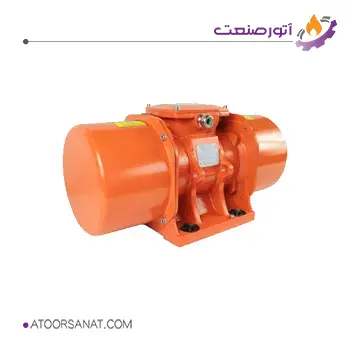Vibrator Motor

What is a Vibrator Motor (Industrial Vibrator)?
In various industries, whenever a vibrating motion, or vibration, is needed, a vibrator motor or industrial vibrator is used. These devices have such a wide range of applications that virtually no industry can do without one of their types.
Industrial vibrators are used in various fields, including vibrating screens, conveyors, sieves, compaction tables, foundry molds, fluid beds, separators, weighing machines, surface finishing machines, spiral or helical elevators, and other devices. Vibrator motors come in various types and sizes, which are selected based on the mechanical characteristics of the devices and the desired performance.
Since the operating mechanism of industrial vibrators is based on the vibration caused by the rotation of an unbalanced weight around the main axis, the shocks and frequency related to their vibration are directly related to the speed of the vibrator motor. In the following, we will examine the types of vibrator motors and the technical features that should be considered when selecting an industrial vibrator.



Operation of a Vibrator Motor
To answer the question of how a vibrator motor works, we must first consider a general classification of vibrators. The first category is small vibrators used in delicate devices where the amount of vibration produced is also required in limited quantities. In these cases, the vibrator’s structure usually consists of a rotating motor to which a sector of a circular weight is attached, or sometimes a circular weight rotates around a point other than the center of the circle, which causes the crank to rotate and create vibration in the motor and, consequently, the device that requires vibration.
The second category is powerful industrial vibrators where several features must be accessible, including the ability to change the vibration frequency and the ability to change the impact intensity, which means that in this type of vibrator, special attention is paid to the design and construction of the vibration-generating mechanism to maintain the mechanical life of the used parts while providing the required vibration.
Industrial vibrators usually have the ability to adjust the vibrating weights. By changing the angle between the two counterweights attached to their axis, the amplitude of oscillation can be affected. These two counterweights, seen in the image, are positioned in such a way that the inner weight is in a fixed position relative to the rotating axis, and you can change the angle of the outer weight relative to the inner weight. Note that manufacturers generally emphasize that the position of the inner weight should never be changed, and only the outer weight should be changed relative to the inner weight.
As seen in the figure, the angle of the weights, which is graduated on the front of the main shaft, is important. For example, in the image above, this angle places the weight position at 40% of the maximum weight amplitude. This angle has different meanings in different vibrators, and you should refer to the catalog of each product specifically. Below is an example of adjusting this angle for one of the vibrator motors:
Since the amplitude of oscillation is important in a vibrator motor, it is necessary to pay attention to the following conceptual points about the amplitude of oscillation:
- The vibration amplitude does not depend on the rotation of the vibration mechanisms.
- The amplitude, along with the rotation of the mechanism, gives a certain amount of acceleration to the equipment, and this acceleration is responsible for applying the effect (including material transfer) in the system.
- The larger the materials to be transferred, the greater the vibration amplitude of the equipment should be.
Therefore, given the above explanations, the importance of adjusting the weights of the vibrator motor for proper operation of the device becomes clear, but another very important point should also be considered: the effect of the amplitude of vibration and its changes on the life of the vibrator bearings and equipment. For this case, consider the following point:
- The higher the intensity and amplitude of the vibrations generated, the more pressure is exerted on the bearings, reducing their lifespan.
- When adjusting the weights, be sure to pay special attention to the technical points mentioned by the manufacturer, including limitations and safety factors.
- Do not forget the most important point of vibration systems, which is that the vibration frequency must always be less than the natural frequency of the connected assembly so that the resonance phenomenon does not cause serious damage to the system.
Considering the above points, it can be concluded that there is always an optimal amount between adjusting the weight, vibration frequency, and equipment life that a professional engineer always considers.
Components of a Vibrator Motor:
The components of a vibrator body are shown in the following two images:
Classification of Industrial Vibrators by Energy Source:
Vibrator motors are classified into two categories based on the energy source for generating the vibrating motion. The first category, which has a longer history in the industry, is powered by air and is therefore called pneumatic industrial vibrators.
The second category, which has gained a wider place in the industry with the development of equipment and technological advances, is electric vibrator motors, which obtain the energy required to supply the vibrating motion from an electric motor.
Although electric vibrator motors are the preferred choice of engineers due to their ease of use and controllable performance, pneumatic vibrators are preferred in cases where there is a risk of fire due to their safety.

